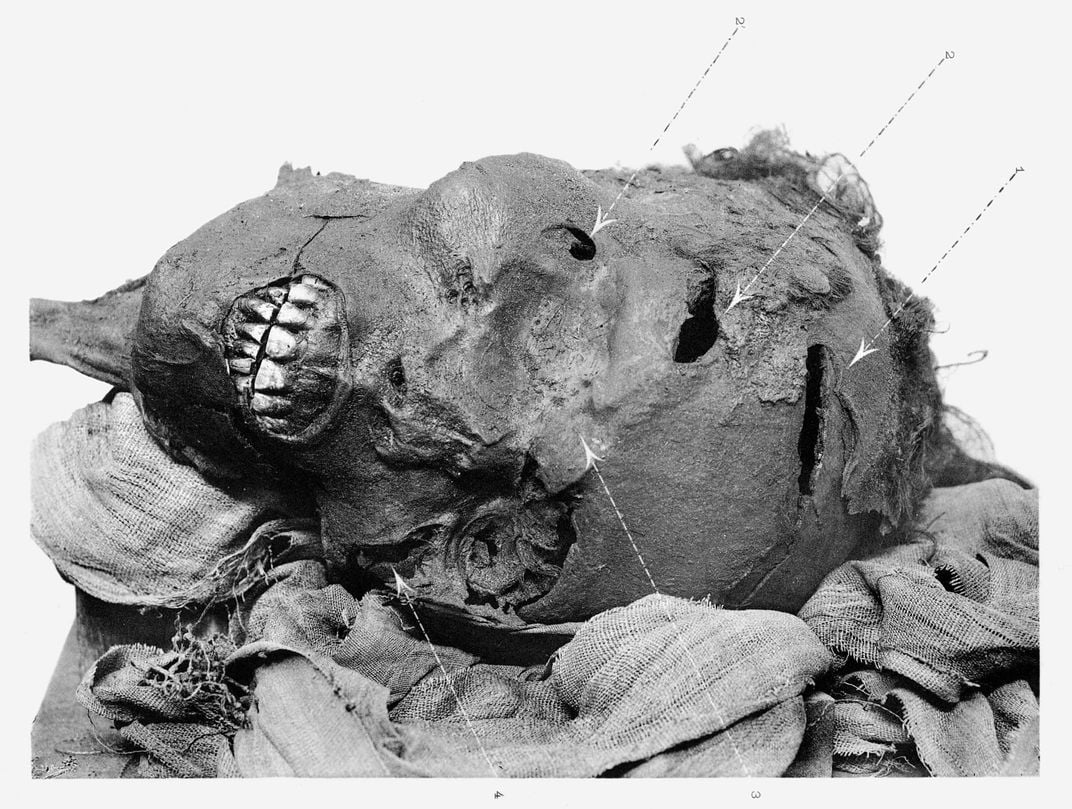CT Scans Suggest Egyptian Pharaoh Was Brutally Executed on the Battlefield
During the 16th century B.C., multiple Hyksos soldiers assaulted the captive Seqenenre-Taa-II, inflicting serious facial and head injuries
:focal(392x308:393x309)/https://tf-cmsv2-smithsonianmag-media.s3.amazonaws.com/filer/06/5e/065e79da-f828-44d4-b047-59a100bf4345/mummy_head.jpg)
Researchers have long known that Egyptian Pharaoh Seqenenre-Taa-II suffered a gruesome death at some point in the 16th century B.C. But the events surrounding the ancient king’s final moments are subject to debate, with some scholars positing that he was murdered in his sleep as the result of a palace conspiracy and others suggesting he died on the battlefield.
A new study published in the journal Frontiers in Medicine draws on computed tomography (CT) imaging, as well as X-ray images taken in the 1960s, to outline the likely circumstances that led to Seqenenre’s violent demise.
As Stephanie Pappas reports for Live Science, CT scans of the pharaoh’s mummy revealed a series of potentially fatal head injuries, including a 2.75-inch gash on the forehead, a deep stab wound at the base of the skull and a 1.25-inch slash above the right eye. Given the absence of defensive injuries, the researchers conclude that combatants from the rival Hyksos dynasty captured and bound the ruler before brutally executing him on the battlefield.
“This suggests that Seqenenre was really on the front line with his soldiers risking his life to liberate Egypt,” says lead author Sahar Saleem, a radiologist at Cairo University, in a statement.
Prior to his execution, Seqenenre’s captors likely tied his hands behind his back, rendering the king defenseless. The still-clenched positioning of his hands and wrists is indicative of “cadaveric spasm,” a condition that “affects the … limbs of individuals who were subjected to violent deaths and whose nervous systems were disturbed at the moment of death,” according to the study.

Once the pharaoh’s hands were bound, multiple enemies attacked him, inflicting blows with such weapons as daggers, double-edged battle-axes and spears. Per Gizmodo’s George Dvorsky, any one of the severe injuries to the head and face could have been fatal, triggering shock, blood loss and intracranial trauma. Together, write Saleem and co-author Zahi Hawass, they were “almost certainly fatal.”
Based on the position of the fracture to Seqenenre’s forehead, the researchers suggest that the attacker responsible for the injury was in a raised position—for example, riding a horse. Alternatively, the king may have been sitting or kneeling. The aggressor probably used a “heavy sharp object like a sword or an ax” to deliver the deadly blow, per the study.
“In a normal execution on a bound prisoner, it could be assumed that only one assailant strikes, possibly from different angles but not with different weapons,” says Saleem in the statement. “Seqenenre’s death was rather a ceremonial execution.”
According to the London Times’ Tom Whipple, earlier examinations of the pharaoh’s mummy—discovered by modern researchers in 1881—had recorded most of these injuries. But the new study offers additional insights, including the “key piece of information” represented by the hands’ cadaveric spasm and previously unknown facial wounds hidden by embalmers. The scans also showed that the ruler was around 40 at the time of his death.
The statement notes that the individuals tasked with preparing Seqenenre’s mangled body for burial attempted to conceal his head wounds beneath a layer of material that acted similarly to fillers in modern plastic surgery. Though researchers had previously attributed the mummy’s poor state of preservation to its embalmers’ lack of adequate supplies, the sophistication evident in these beautification efforts contradicts that line of thinking. As Gizmodo explains, it’s more likely that Seqenenre’s embalmers only began the mummification process after he started decaying—a reasonable explanation given the difficulties associated with retrieving remains from the battlefield.
/https://tf-cmsv2-smithsonianmag-media.s3.amazonaws.com/filer/02/18/021869a7-5c15-4047-bff8-19ec8088a864/255710_web.jpg)
Seqenenre ruled southern Egypt during the Hyksos occupation of Egypt’s northern territories (roughly 1638 to 1530 B.C.). Originally immigrants from the Levant, the Hyksos allowed pharaohs to preside over southern Egypt as long as they paid tribute to Hyksos rulers.
Ancient sources tell of rising tensions between the Hyksos king Apophis and Seqenenre during the 16th century B.C. Apophis reportedly sent the pharaoh an inflammatory note complaining that loud hippopotamuses in a pool in Thebes were disturbing his sleep and demanding that the hallowed pool be destroyed.
Given the fact that Apophis lived 400 miles away from Thebes, in the Hyksos capital of Avaris, Seqenenre viewed his decree as a “grave insult,” according to Live Science. Archaeologists aren’t sure what happened next, but one account indicates that Seqenenre called his counselors together after the incident, kickstarting the bloody war that ultimately led to his death.
The pharaoh’s sacrifice wasn’t entirely in vain. As Kristin Baird Rattini wrote for National Geographic in 2019, Seqenenre’s son Ahmose I later spearheaded an uprising that expelled the Hyksos, reunited Upper and Lower Egypt, and ushered in a prosperous era known as the New Kingdom.
“Seqenenre’s death motivated his successors to continue the fight to unify Egypt and start the New Kingdom,” says Saleem in the statement.
/https://tf-cmsv2-smithsonianmag-media.s3.amazonaws.com/accounts/headshot/Isis_Davis-Marks_thumbnail.png)
/https://tf-cmsv2-smithsonianmag-media.s3.amazonaws.com/accounts/headshot/Isis_Davis-Marks_thumbnail.png)